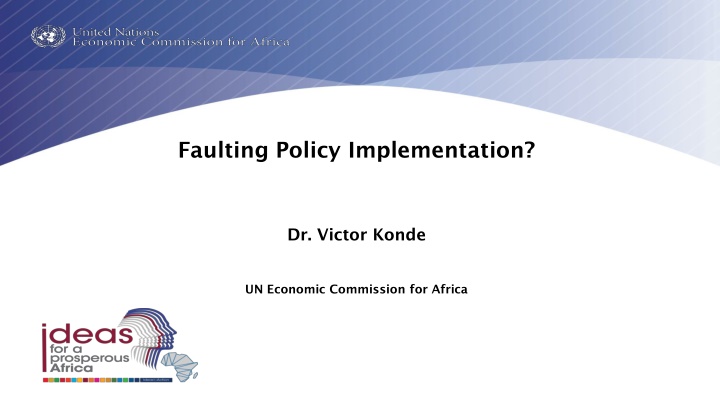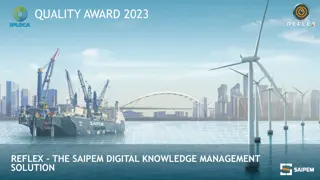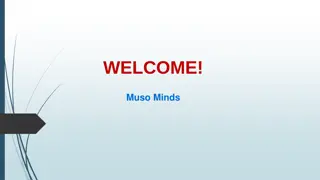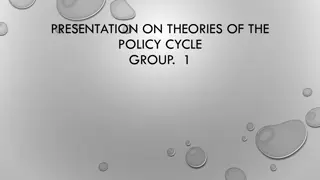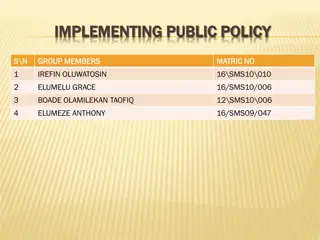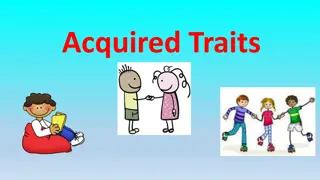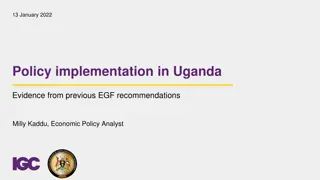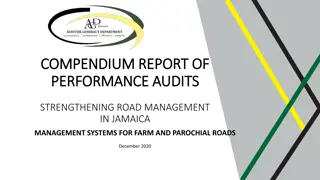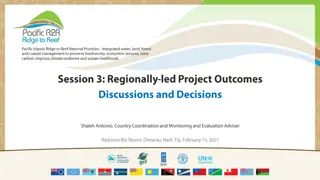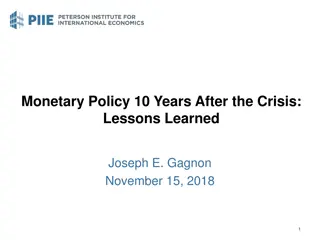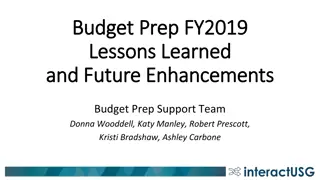Challenges in Policy Implementation and Lessons Learned
The content discusses the challenges faced in policy implementation, focusing on the gap between policy design and execution. It highlights key steps in policy-making, reasons for implementation failures, and factors influencing successful policy outcomes. Examples from Zambia's National Science and Technology Policy (NSTP) of 1996 are analyzed to illustrate these challenges. The text emphasizes the importance of stakeholder engagement, clear planning strategies, and coordination for effective policy implementation.
Download Presentation

Please find below an Image/Link to download the presentation.
The content on the website is provided AS IS for your information and personal use only. It may not be sold, licensed, or shared on other websites without obtaining consent from the author.If you encounter any issues during the download, it is possible that the publisher has removed the file from their server.
You are allowed to download the files provided on this website for personal or commercial use, subject to the condition that they are used lawfully. All files are the property of their respective owners.
The content on the website is provided AS IS for your information and personal use only. It may not be sold, licensed, or shared on other websites without obtaining consent from the author.
E N D
Presentation Transcript
Faulting Policy Implementation? Dr. Victor Konde UN Economic Commission for Africa
The lonely step in STI Policy Making: Implementation 1. Agenda setting Define the problem (identify causes, size and who is affected, and where) and define associated objectives 2. Policy Analysis Frame questions, performance and future options, techno-socio-economics viability, and prioritise 6. Policy Evaluation Monitoring, management and evaluation assess past 5. Policy implementation Actions: What by who, when and where, what scale 3. Policy Formulation a. Draft policy b. Design implementation process (strategy) 4. Policy Adoption Process (technical committee, cabinet, parliament approvals)
Revisit assumptions of implementation failure/gap Politicians make policies while bureaucrats implement Is there a clear separation of roles; Politicians & policy implementation Policies are good in design but poorly implemented Is there a clear plan/strategy in place? Is it realistic? Poor stakeholder engagement? Do they have any stake, which stake, how large or how small? Are roles clearly defined, commitment secured or arbitrarily assigned? Fragmentation, duplication of efforts or competition? Policy and inaction Codified or uncodified, is policy action needed? Lack of policy results IS NOT action?
Appreciating some causes of implementation failure failure is rarely unequivocal and absolute even policies that have become known as classic policy failures also produced small and modest successes .. Manage political commitment Vested interests of stakeholders and their interests and relationships Enhance their absorptive capacity of complex and interlinked issues (e.g. 4IR) High political commitment is often a disadvantage to success (need space to experiment) Overly optimistic policy agendas Beyond reach? Resource, technological and industrial targets that are unattainable, etc. Inadequate coordination arrangements Governance of mechanisms for knowledge exchange (silo!), shared vision and interests, etc. Poor collaborative problem-solving platforms A platform where key players meet periodically, review progress, make adjustments Rapidly revolving political cycle Short-term gains, low hanging fruits and so forth versus long-term and strategic outcomes
Goals and Objectives Goals 1. Enhancing linkages between technology research institutes, the private and public sector to encourage demand-driven research and development; 2. Developing and sustaining a national scientific and technological capacity and providing highly skilled human resource for increased productivity in the economy; 3. Fostering national and international linkages for enhanced technology transfer; and 4. Facilitating the acquisition, adaptation and utilization of foreign technology. Objectives embed science and technology [in] key sectors for promoting competitiveness in the production of a wider range of quality goods and services . Recognizing gender concern; changing institutional structure; ensuring that research is guided by national developmental goals; establishing a mechanism for increased innovation, transfer, diffusion and commercialization of technology.
The main asks 1. Separate R&D from policy advice and technology commercialization 2. Establish the Depart. of S&T in the Ministry 3. Establish post of S&T Advisor to the President 4. Create S&T Development Fund and Venture Fund 5. Introduce tax breaks for R&D, commercialization, licensing and other tech inputs 6. Allocate 3% of GDP to S&T
Implementation Accomplished Separate R&D from policy advice and commercialization NISIR for R&D, NCST for Advice and NTBC for ToT created Establish the Depart of S&T Introduce tax breaks for R&D, commercialization, licensing and other tech inputs Most already existed for public and private R&D, tech transfer and capital goods Not accomplished Establish post of S&T Advisor to the President Create S&T Development Fund and Venture Capital (VC) Fund Some funds but not VC or standalone funds Allocate 3% of GDP to S&T No too ambitious and unrealistic
Causes of Implementation challenges? Internal conflicts or interests? (Case of Science Advisor) The Head of NCSR was automatically Science Advisor to, appointed by, and reported to the President and; Chaired or was board member of other public R&D entities. The 1996 policy changed in favour of independent office. STI community Lost both Unclear mandates (case of VC) None of the entities could run a venture capital fund - NTBC can neither take equity in nor give loans to firms. Legally not feasible Unreasonable ask (case of 3% of GDP) Very few countries meet R&D expenditure of 3% of GDP none at Zambia s level of economic development ever. 3% of GDP is about 8-10% of national budget (more than the entire budget for Health or Education). Over-optimistic/ unrealistic Strong political commitment? (case of institutions) Almost all institutions established, benefited the same teams championing the policy - Extremely inward looking
Implementation beyond good expectations As a lonely step and happens late Several meetings, travels and teams involved in formulation but almost NONE in implementation Assumed to be logical progression Goal determine institutions, institutions determine outcomes, but rather complex, non-linear and in everchanging environment (cases of Internet, mobile, biotech) The links between goals and the planned actions embed science and technology [in] key sectors for promoting competitiveness in the production of a wider range of quality goods and services and establishment of institutions is weak Implementation always bring new issues on the agenda Things never go as planned one route to the President was cut and new one was not created Blurring distinctions between policy formulation and implementation (e.g. health decisions are self-implementing and similarly renaming NCSR to NISIR required just change in law- made it even weaker in all aspects) Absence of an implementation plan (e.g. Acts establishing institutions include all key details like a plan) but outcomes and goals require Acts more than Acts/laws require ACTION!
What are the targets of your national STI on agriculture?
Judging STI Harshly? Case of Food Insecurity Widespread lack of access Burundi: Weather extremes, high food prices Chad: Civil insecurity, shortfall in cereal production Democratic Republic of the Congo: Civil insecurity in eastern areas, high food prices Djibouti: Unfavourable weather, high food prices Eritrea: Macroeconomic challenges Ethiopia: Conflict in Tigray Region, drought conditions in southeastern areas, high food prices Malawi: Localized shortfalls in cereal production, high food prices Nigeria: Conflict in northern areas, localized shortfalls in cereal production, high food prices South Sudan: Economic downturn, floods, civil insecurity Zimbabwe: High food prices Exceptional shortfall in food supplies Central African Republic:Conflict, population displacement, high food prices, floods Kenya:Drought conditions Niger:Conflict, shortfall in cereal production Somalia:Drought conditions, civil insecurity
Understanding the major causes of policy implementation failure in your environment can inform the design of measures to enhance policy implementation and effectiveness. The boundaries between policy formulation and implementation may be blurred and raise issues that may need policy action No policy fails or succeeds absolutely: design a clear implementation plan while being flexible to changes that may will arise
